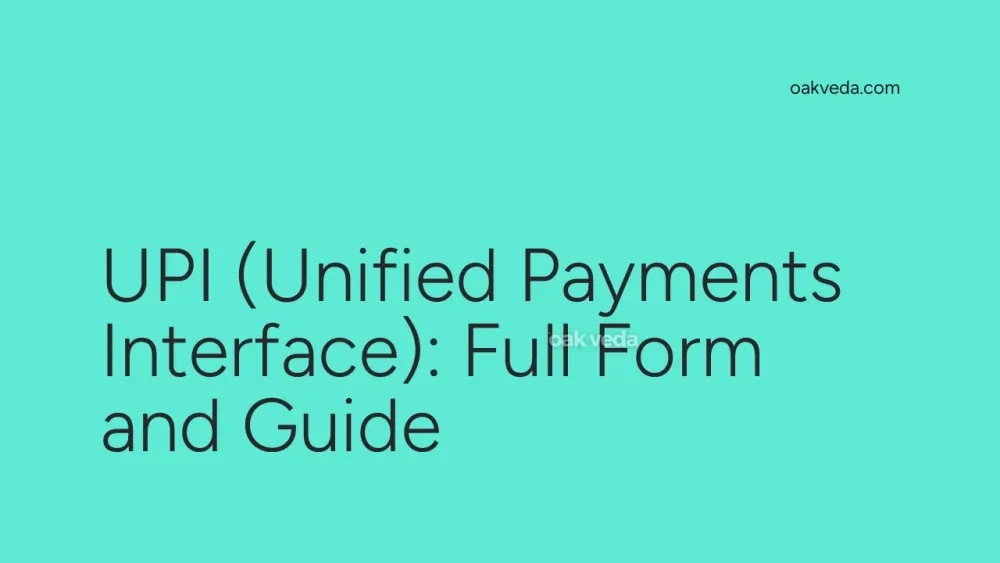
What is the Full Form of UPI?
The full form of UPI is Unified Payments Interface. This innovative digital payment system has revolutionized the way financial transactions are conducted in India, offering a seamless and secure method for transferring money between bank accounts.
What is Unified Payments Interface?
Unified Payments Interface, commonly known as UPI, is a real-time payment system developed by the National Payments Corporation of India (NPCI). It facilitates instant fund transfers between two bank accounts through a mobile platform. UPI has simplified the process of sending and receiving money, making it as easy as sending a text message.
Origin and Development of Unified Payments Interface
The concept of UPI was introduced in 2016 under the guidance of the Reserve Bank of India (RBI) and the Indian Banks' Association (IBA). It was designed to create a unified system that could integrate multiple bank accounts into a single mobile application, providing a seamless fund routing and merchant payment system.
How does Unified Payments Interface work?
UPI operates on a simple yet powerful mechanism:
- Users create a Virtual Payment Address (VPA) of their choice.
- This VPA is linked to one or more bank accounts.
- To transfer money, users only need to know the recipient's VPA.
- Transactions are authenticated using a Mobile Banking Personal Identification Number (MPIN).
This system eliminates the need for entering bank account details, IFSC codes, or net banking credentials for every transaction, making the process quick and user-friendly.
Functions of Unified Payments Interface
UPI serves several key functions in the digital payment ecosystem:
- Instant Fund Transfer: Enables real-time money transfers between bank accounts.
- Merchant Payments: Facilitates easy payments for goods and services.
- Bill Payments: Allows users to pay utility bills, recharge mobile phones, and more.
- QR Code Payments: Supports scanning QR codes for quick transactions.
- Request Money: Enables users to request payments from others.
Applications of Unified Payments Interface
UPI has found widespread applications across various sectors:
- Retail Payments: Used for in-store and online purchases.
- Peer-to-Peer Transfers: Facilitates money transfers between individuals.
- E-commerce: Integrated into online shopping platforms for seamless checkouts.
- Government Services: Adopted for tax payments and other government transactions.
- Subscription Services: Used for recurring payments like OTT subscriptions.
Features of Unified Payments Interface
UPI boasts several innovative features that set it apart:
- 24/7 Availability: Transactions can be made at any time, including holidays.
- Multi-Bank Support: A single app can access multiple bank accounts.
- Virtual Payment Address: Unique identifier that masks bank details.
- Immediate Settlement: Transactions are processed in real-time.
- Secure Authentication: Uses MPIN for transaction verification.
- Interoperability: Works across different banks and payment service providers.
Benefits of Unified Payments Interface
The adoption of UPI has brought numerous benefits:
- Convenience: Simplifies the process of sending and receiving money.
- Speed: Enables instant fund transfers.
- Cost-Effective: Most UPI transactions are free for users.
- Enhanced Security: Eliminates the need to share sensitive bank details.
- Financial Inclusion: Makes digital payments accessible to a wider population.
- Reduced Cash Dependency: Promotes a shift towards digital transactions.
Limitations or Challenges of Unified Payments Interface
Despite its advantages, UPI faces some challenges:
- Transaction Limits: Daily and per-transaction limits set by banks.
- Dependence on Internet: Requires stable internet connectivity.
- Technical Glitches: Occasional system downtimes or failed transactions.
- Security Concerns: Potential for fraud if device or VPA is compromised.
- User Education: Need for awareness about safe usage practices.
Future Developments in Unified Payments Interface Technology
The future of UPI looks promising with several developments on the horizon:
- International Expansion: Plans to extend UPI services to other countries.
- Enhanced Security Measures: Implementation of advanced fraud detection systems.
- Integration with Emerging Technologies: Potential incorporation of blockchain and AI.
- Increased Transaction Limits: Discussions to raise current transaction caps.
- Offline Transactions: Development of UPI functionality without internet connectivity.
FAQs on UPI Full Form
-
What is the full form of UPI? The full form of UPI is Unified Payments Interface.
-
Is UPI available 24/7? Yes, UPI services are available 24 hours a day, 7 days a week, including holidays.
-
Can I link multiple bank accounts to UPI? Yes, you can link multiple bank accounts to a single UPI app.
-
Is there a charge for UPI transactions? Most UPI transactions are free for users, but banks may charge for certain services.
-
How secure is UPI? UPI is highly secure, using MPIN authentication and not sharing bank details directly.
In conclusion, the Unified Payments Interface (UPI) has emerged as a game-changer in India's digital payment landscape. Its full form - Unified Payments Interface - aptly describes its role in unifying various banking services into a single, user-friendly platform. As UPI continues to evolve and expand, it promises to play an even more significant role in shaping the future of digital transactions in India and potentially beyond.
You may be interested in:

